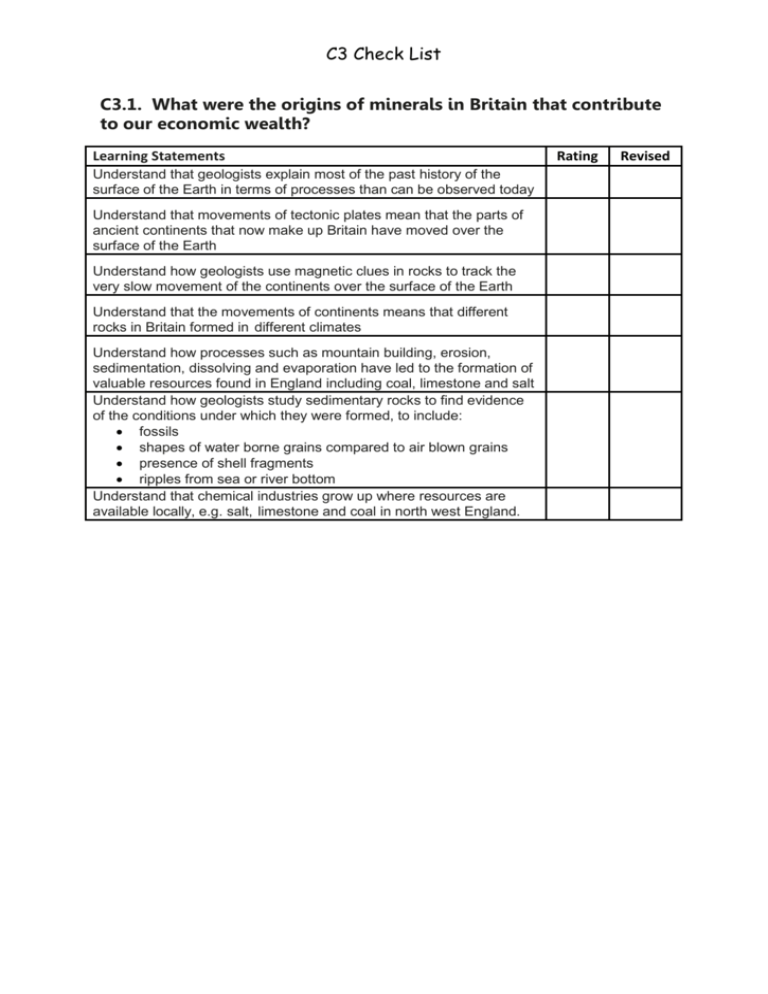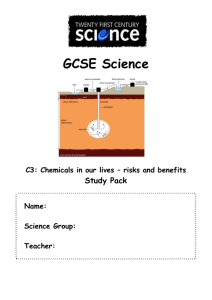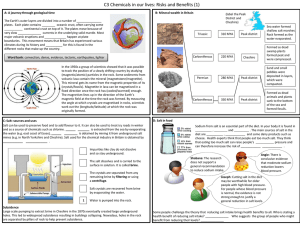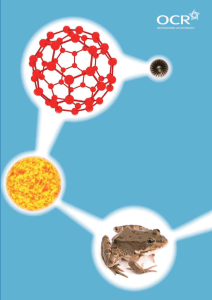chemistry-c3-checklist
advertisement

C3 Check List C3.1. What were the origins of minerals in Britain that contribute to our economic wealth? Learning Statements Understand that geologists explain most of the past history of the surface of the Earth in terms of processes than can be observed today Understand that movements of tectonic plates mean that the parts of ancient continents that now make up Britain have moved over the surface of the Earth Understand how geologists use magnetic clues in rocks to track the very slow movement of the continents over the surface of the Earth Understand that the movements of continents means that different rocks in Britain formed in different climates Understand how processes such as mountain building, erosion, sedimentation, dissolving and evaporation have led to the formation of valuable resources found in England including coal, limestone and salt Understand how geologists study sedimentary rocks to find evidence of the conditions under which they were formed, to include: fossils shapes of water borne grains compared to air blown grains presence of shell fragments ripples from sea or river bottom Understand that chemical industries grow up where resources are available locally, e.g. salt, limestone and coal in north west England. Rating Revised C3 Check List C3.2 Where does salt come from and why is it so important? Learning Statements Understand the importance of salt (sodium chloride) for the food industry, as a source of chemicals and to treat roads in winter Recall that salt can be obtained from the sea or from underground salt deposits Understand how underground salt can be obtained by mining, or by solution in water Understand why the method used to obtain salt may depend on how the salt is to be used Understand how the methods of obtaining salt can have an impact on the environment Understand the advantages of adding salt to food as flavouring and as a preservative Recall the health implications of eating too much salt Be able to evaluate data related to the content of salt in food and health Recall that Government departments, such as the Department of Health and the Department for Environment, Food and Rural Affairs, have a role in: carrying out risk assessments in relation to chemicals in food advising the public in relation to the effect of food on health. Rating Revised C3 Check List C3.3 Why do we need chemicals such as alkalis and chlorine and how do we make them? Learning Statements Recall that, even before industrialisation, alkalis were needed to neutralise acid soils, make chemicals that bind natural dyes to cloth, convert fats and oils into soap and to manufacture glass Recall that traditional sources of alkali included burnt wood or stale urine Understand that alkalis neutralise acids to make salts Understand that increased industrialisation led to a shortage of alkali in the nineteenth century Understand that the first process for manufacturing alkali from salt and limestone using coal as a fuel caused pollution by releasing large volumes of an acid gas (hydrogen chloride) and creating great heaps of waste that slowly released a toxic and foul smelling gas (hydrogen sulfide) Understand that pollution problems can sometimes be solved by turning wastes into useful chemicals Understand that oxidation can convert hydrogen chloride to chlorine, and that the properties of a compound are completely different from the elements from which it is made Recall that chlorine is used to kill microorganisms in domestic water supplies and as a bleach Understand how the introduction of chlorination to treat drinking water made a major contribution to public health Interpret data about the effects of polluted water on health and the impact of water treatment with chlorine to control disease Understand that there may be disadvantages of chlorinating drinking water, including possible health problems from traces of chemicals formed by reaction of chlorine with organic materials in the water Understand that an electric current can be used to bring about chemical change and make new chemicals through a process called electrolysis Recall that chlorine is now obtained by the electrolysis of salt solution (brine) Recall examples of important uses by industry of the sodium hydroxide, chlorine and hydrogen produced by electrolysis of brine Interpret data about the environmental impact of the large scale electrolysis of brine. Rating Revised C3 Check List C3.4 What can we do to make our use of chemicals safe and sustainable? Learning Statements Understand that there is a large number of industrial chemicals with many widespread uses, including consumer products, for which there is inadequate data to judge whether they are likely to present a risk to the environment and/or human health Understand that some toxic chemicals cause problems because they persist in the environment, can be carried over large distances, and may accumulate in food and human tissues Recall that PVC is a polymer that contains chlorine as well as carbon and hydrogen Understand that the plasticizers used to modify the properties of PVC can leach out from the plastic into the surroundings where they may have harmful effects Understand that a Life Cycle Assessment (LCA) involves consideration of the use of resources including water, the energy input or output, and the environmental impact, of each of these stages: making the material from natural raw materials making the product from the material using the product disposing of the product When given appropriate information from a Life Cycle Assessment (LCA), compare and evaluate the use of different materials for the same purpose. Rating Revised









